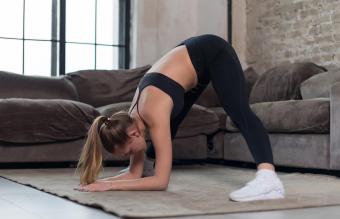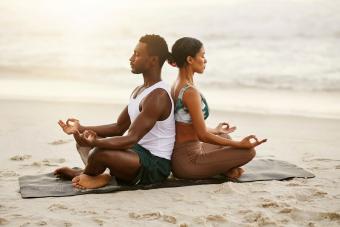
Whether for peace of mind or stretching and strengthening, you may have many reasons for loving your yoga class. The benefits add up quickly, from better weight control to greater flexibility. But here's another one: Yoga can make you smarter.
Try These Five
So, how do you add "smarter" to the stretching and strengthening benefits of your yoga practice? A daily sequence with a variety of poses will always help. In general, yoga is good for you and your mind. However, no matter the level of your yoga expertise, you can add a few poses to your line-up to emphasis the brain-building side of the equation.
Thunderbolt Pose

Thunderbolt or vajrasana is a breathing and meditation posture that increases awareness, stretches the fronts of the legs all the way to the feet, and improves posture. The pose promotes calm and concentration and may be used for meditation or pranayama -- focused breathing -- exercises.
- Kneel and sit back on your legs with the tops of your feet flat on the mat.
- Keep your spine tall and rest your hands lightly on your thighs.
- Breathe evenly and deeply and concentrate on lengthening your spine.
- Hold the pose as long as it is comfortable, building up your time until you can stay in Thunderbolt for pranayama or for meditation.
Reclining Hero Pose

Reclining hero pose, or supta virasana, is an intermediate follow-on pose to vajrasana. You should learn it under the guidance of a certified teacher to avoid injuring yourself by using bad form or pushing past your limits. BKS Iyengar considered reclining hero to be an advanced pose, a backbend to silence the outer mind and engage the inner mind. Iyengar taught that deep backbends accelerated circulation and, through the opening of the chest, eased depression. The wide ribcage and expanded lungs encourage full, easy breathing, and the pose triggers your parasympathetic nervous system, slowing your heartbeat, lowering your blood pressure, and completely relaxing you. Try reclining hero with a supportive folded blanket or cushions until you are steady and flexible enough to do without props.
- Kneel in vajrasna.
- Lower your hips until you are sitting on the mat with your hips between your heels.
- Keep your thighs parallel, place your hands on the floor, and ease back onto your forearms and elbows, maintaining an elongated spine.
- Slip your hands under your pelvis, spread your butt cheeks to the side and toward your tailbone, and recline with control onto your blanket or yoga mat.
- Leave your hands by your sides and relax into the backbend for at least 30 seconds.
- Release the pose by resting your weight on your forearms, then your hands, as you lead with your sternum into vajrasana.
Sphinx Pose

Kick-start your kundalini energy with sphinx, the easy version of cobra pose for beginners or anyone not yet flexible enough for the deeper backbend of bhujangasana. Sphinx pose (ardha bhujangasana or half-cobra) sharpens the mind and improves memory as it releases tension in the shoulders, back, and hips. The modified arch gently refreshes the flow of energy up the spine to the brain. Backbends, especially sphinx and cobra, are related to chakra opening in traditional scriptures. They compress the spine during the backwards arc and then free that energy in a rush when the pose is released. All seven chakras, or energy centers, are stimulated.
In sphinx, you shift focus from lengthening the extended legs to engaging your core and scooping your belly to keeping your tongue, eyes, and mind still. It can help to train your eyes on a single point on the wall in front of you, or just soften your gaze so your focus is inward and not on the world around you. As the arch of your back is released at the end of the pose, the energy travels from your lower chakras to the throat, third eye, and crown chakras, the seats of truth, understanding, and intuition. Oxygen flow increases with open chest breathing, and blood flow to the brain is invigorated through the contraction and letting go. Completion of the pose leaves you refreshed and relaxed with an energy boost to clear your mind.
- Lie face-down on your mat, legs together and long, and think of pressing your outer thighs toward the mat to open and protect your lower back.
- Keep your feet and the fronts of your thighs on the mat as you reach your toes behind you to increase your extension.
- Arrange your elbows under your shoulders and feel your parallel forearms grounded on the mat to support you.
- Inhale and lift your head and upper torso into an easy backbend. Stay on your forearms. Don't push all the way up to straighten your elbows and don't try for an exaggerated arch.
- Stay relaxed but continue your leg extension and scoop your belly to engage your core without tightening your glutes.
- Look straight ahead or soften your focus, but keep your head up just enough to feel the stretch in your upper back and shoulders.
- Breathe evenly for at least 30 seconds before releasing the pose on a long slow exhale.
- As you become stronger, remain in the pose longer before releasing.
Big Toe Pose

Big toe pose, or padahastasana, is a forward bend and another excellent posture to improve blood flow to your brain. Circulation-boosting poses that target the brain are memory sharpeners and calm your nervous system, a win-win for mental clarity. Yoga Journal says big toe and other forward bends aid in relieving stress, anxiety, and mild depression. There's no more brain fog, and it's a good stretch to unkink tight muscles and lengthen your spine.
- Stand upright with feet parallel. Exhale and bend forward from your hips.
- Reach your big toes with the index and middle fingers of each hand and wrap those fingers around your toes, pressing the big toes strongly into the mat.
- Inhale. Lift and lengthen your torso; exhale and lift your butt.
- Focus on relaxing your muscles to increase the stretch.
- Use a yoga band hooked around your insteps if you can't quite reach your toes. Grasp the band, keeping your legs straight (not bent), and work the stretch.
- Repeat for two or three breaths and then exhale, grip your toes tightly, bend your elbows, and lower your forehead to your shins in a forward bend.
- Hold for 15 to 30 seconds, release your toes, and bring your torso and head to upright.
Shoulder Stand

Shoulder stand, or sarvangasana, reverses the effect of gravity on your circulation as you point your toes at the sky. The inversion boosts memory power by increasing the blood supply to your brain -- good for improved mental alertness and concentration. Be careful in this pose to protect your delicate neck. Most teachers recommend using a folded or rolled towel to support your head and prevent excess compression of the neck. Shoulder stand is a kind of cure-all asana that alleviates a number of conditions, from chronic fatigue to asthma. However, it isn't for everyone. Avoid it if you have hypertension, glaucoma, neck problems, arteriosclerosis, kidney disease, or are menstruating. When in doubt, check with your health care provider for an all-clear.
- Lie on your back on the mat, arms at your sides and legs long.
- Inhale and raise both legs together using your strong core, not your back.
- Bring the extended legs over your head, pointing at the wall behind you but not parallel to the floor.
- Move your hands under your hips to support your lower back as you reach your legs straight up.
- In one fluid move, lift your legs and raise your lower back off the mat, resting your weight on your shoulder blades.
- Your upper arms, which are flat on the mat, help steady your body along with your flat palms against your lower back.
- Relax and breathe evenly for as long as you are comfortable.
- Then, continue to support your lower back as you roll through your torso, hips, and buttocks to the floor and slowly lower your extended legs.
More Brain Boosters

A rich and varied yoga practice mixes balance, focus, relaxation, stretching, and circulation boosters. Practice the following poses at your own pace, concentrating on even breathing as you work to perfect the form. You may have to start simple, an instep resting against an ankle instead of a calf, a half-lotus to favor stiff leg muscles. But you get the benefit from the mindful attention and repetition, even as you increase your skill from beginner yogi to advanced.
Tree Pose
Tree pose, or vrikshasana, requires complete stillness and focus to maintain balance without wobbling and continue even breathing. Enhance concentration with your hands over your head in prayer position, and one knee bent so the foot rests on the opposite thigh.
Downward Facing Dog
Downward Facing Dog, adho mukha shvanasana, has a lot happening at once. Work for smooth transitions from all fours to the triangular head-down shape that lengthens hamstrings and stretches calves. The lowered head position promotes increased blood flow to your brain, and you'll be working your memory to keep track of each move and pose in the sequence.
Lotus Pose
Lotus pose, or padmasana, is deceptively simple and the most secure seat for meditation. If you can't quite manage both feet resting on opposite thighs, try a modified lotus with just one foot on top of one thigh and the other on the floor. Meditation calms and clears the mind and is credited with a wealth of brain-enhancing benefits, including increasing gray matter in your frontal cortex, which improves executive decision making and working memory.
Corpse Pose
The challenge of corpse pose, or savasana, is to stay awake. The corpse pose is all about relaxing, and a skillful studio teacher will take your attention from your toes to the top of your head, softly reminding you to let go of all tension. Lie flat on your mat in this pose to allow all tightness and stress to drain from your body, freeing your mind from its endless loop of worries and reminders. How does it work? Savasana slows your busy beta brain waves to more relaxed and creative alpha frequencies. Adept yogis can even reach theta state, an almost dreamlike clarity and consciousness.
Salute to the Sun

Salute to the sun, or surynamaskar, is the classic series of hatha yoga asanas that wake up your mind and body at the beginning of the day. It includes a number of poses that boost circulation to the brain, require careful attention to the sequence of moves, and challenge balance and muscle strength, improving concentration, confidence, working memory and mental flexibility. Try this one any time of day for a quick wake-up instead of a cup of coffee.
"Smarter" Asana Studies
The practice and poses promote focus and lower stress, two brain boosters that improve memory, mental flexibility, and speed and accuracy in performing intellectual tasks. Studies of college students found that as few as 20 minutes of yoga immediately improved cognitive performance for female college students. Seniors in another study, who worked through a hatha yoga class three times a week for eight weeks, outperformed a control group significantly in cognitive ability. The yoga participants showed marked gains in executive function, blazing past the exercise-only group in mental flexibility and mindset, shifting as well as in expanded working memory.
Your Brain on Yoga
Get smart and roll out your mat. You'll manage stress better, maintain calm longer, boost your feel-good endorphins, and increase your attention span. Those downward facing dogs will make you look positively brilliant to your yoga-free friends -- or at least help you to remember where you last tossed the car keys.







